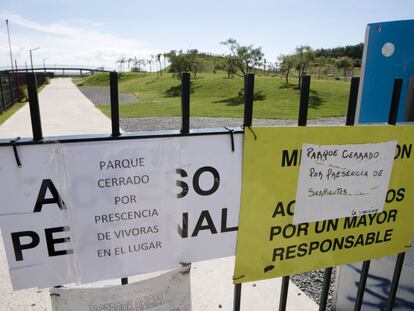Two Spaniards treated for rabies after separate bat bites during summer
The victims, a 59-year-old woman in Valladolid and a 19-year-old man in Huelva, are in good health after having immediately sought medical attention

Two people in Spain had to seek medical treatment this summer after being bitten by bats with rabies. The first case took place on June 21, near the northern Spanish city of Valladolid, while the second happened just two days later more than 650 kilometers away in the southern city of Huelva.
In the first incident, a 59-year-old woman was bitten by the animal when she opened a cupboard in her house and it flew out from within. The second case saw a 19-year-old man bitten after he tried to take the bat away from his cat, which was toying with it.
They were lucky and the health services have worked well
Rufino Álamo, Castilla y León regional government
Since 1987, there have been just 17 cases of people being attacked by bats in Spain.
The two victims are in a good state of health after receiving early treatment against rabies, which involves cleaning the wound, an injection of rabies immune globulin, and a course of vaccinations. In both cases, the victims took the bats with them to the health center, allowing for analysis at the National Microbiology Center. Both animals were carrying European bat Lyssavirus type 1 (EBLV-1).
“They were lucky and the health services have worked well,” said Rufino Álamo, the head of public health information for the Castilla y León regional government. “Rabies is deadly in practically all cases if it develops. It’s important to remember that if anyone is in a similar situation, they should wash the wound well with water and soap and immediately seek medical help at a public center. It is also good to explain to children, who usually play with animals if they find them, that they shouldn’t touch bats and, in the case of a bite, they should immediately tell their parents.”
The coincidence of the two cases taking place in barely three days is attention grabbing, but not statistically important, experts say
The coincidence of the two cases taking place in barely three days is attention-grabbing, but not statistically relevant, experts say. “It could be either a coincidence or the early signs of something, but we don’t have the data to reach conclusions,” says Elías Fernando Rodríguez Ferri, a professor in animal health at the University of León.
The rabies viruses are divided into what researchers call “two cycles.” The so-called “urban” cycle, caused by just one virus, causes around 60,000 deaths a year worldwide, almost always due to dog bites in developing countries. “The dog gets the virus from a wild animal, and if it hasn’t been vaccinated, it develops the disease,” explains Rodríguez Ferri. “Its behavior changes, it becomes aggressive and transmits rabies by biting other mammals in its environment – dogs, horses – and also human beings.”
The last outbreak of the urban cycle in Spain took place in Málaga in 1975, killing two people. After mass vaccination campaigns in the 1960s and 1970s, there were no more reported cases in the country. But in 2004 a woman of Moroccan origin died in Madrid after having contracted rabies in her country, where rabies in dogs is yet to be wiped out.
The last outbreak of the “urban cycle” of rabies in Spain took place in Málaga in 1975, and caused the deaths of two people
The “bat cycle” is caused by the other viruses in the family. Some of these viruses cause the animals to get sick, but others simply carry the virus and transmit it, without suffering any of the ill-effects.
“In this case, the virus travels directly from the carrier to humans,” explains Rodríguez-Ferri. “If anyone comes into contact with a bat, they risk contracting the virus. That’s why it’s important not to touch them, dead or alive.”
In the rest of Europe, a dozen people have died over the last 20 years after being bitten by bats and not requesting medical assistance until the symptoms started to develop. In the United States, around three people die every year of the same cause. The symptoms in humans include fever, changes in mood, nausea and vomiting, photophobia, drooling and convulsions.
English version by Simon Hunter.
Tu suscripción se está usando en otro dispositivo
¿Quieres añadir otro usuario a tu suscripción?
Si continúas leyendo en este dispositivo, no se podrá leer en el otro.
FlechaTu suscripción se está usando en otro dispositivo y solo puedes acceder a EL PAÍS desde un dispositivo a la vez.
Si quieres compartir tu cuenta, cambia tu suscripción a la modalidad Premium, así podrás añadir otro usuario. Cada uno accederá con su propia cuenta de email, lo que os permitirá personalizar vuestra experiencia en EL PAÍS.
¿Tienes una suscripción de empresa? Accede aquí para contratar más cuentas.
En el caso de no saber quién está usando tu cuenta, te recomendamos cambiar tu contraseña aquí.
Si decides continuar compartiendo tu cuenta, este mensaje se mostrará en tu dispositivo y en el de la otra persona que está usando tu cuenta de forma indefinida, afectando a tu experiencia de lectura. Puedes consultar aquí los términos y condiciones de la suscripción digital.










































